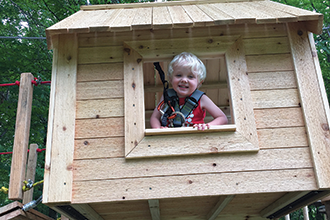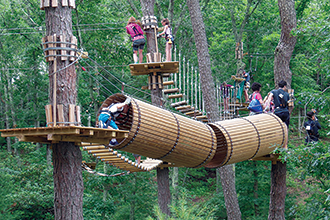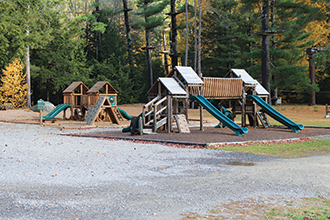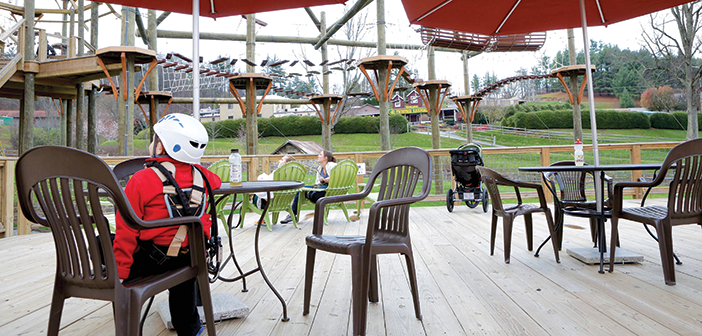What do you do with the youngest of park guests, the ones who still wear Pull-ups but can’t do pull-ups? The ones that like to jump and fly, but who need water and shade and a bathroom—right now! It’s a challenge that adventure park operators, including several new parks, have addressed in creative fashion.
Parks typically take two approaches. Some offer a kids-sized ropes course, with all that entails. Others offer other physical activities, from playgrounds to water sports. In all these options, parks take steps to accommodate the needs and attention spans of kids. Here are several examples.
High Gravity Adventures: Deck with a View
High Gravity Adventures aerial park in Blowing Rock, N.C., opened in April 2015, on the same property as the Wild West-themed Tweetsie Railroad. From a kid-sized course to a well-planned layout, the park was created with the entire family in mind.
At HGA, the Foothills Course was specifically designed for kids ages four to 10, says marketing director Alicia Green. Belay cables on the course were installed at a four-foot height, so kids can reach and move their own tethers.
“The aerial challenges that the kids will meet are similar to those in the main course,” says Green. “This way, the little explorers can experience the same kind of challenges as their bigger siblings or other adult family members, in a park built for them.”
The Foothills Course leaves from the Main Course at a large central platform, the Quad Deck. The hub-and-spoke layout allows all guests, including kids, to enter into one staff-controlled area, from which the staff direct guests into a course. Kids meet staff on the Deck, where the kids are attached to the belay cables and given another equipment check before they enter the course. In designing the course, HGA considered how little or how much parents would be involved. HGA crafted a solution that addresses parents who want to explore the course with their kids as well as others who prefer to just watch.
“We designed the Foothills Course to be used by kids, so they can develop some independence and challenge themselves,” explains Green. Non-participatory parents “play an important role as the support crew by taking pictures, cheering, and encouraging their aerial explorers,” she says. These moms and dads can watch and talk to their kids, and remind them of all the lessons from ground school, from the Basecamp Observation Deck only a few feet from Foothills Course. The deck is outfitted with chairs, tables, and umbrellas.
Parents who want to explore the course with their kids are welcome to do so. Though the course is small, parents are permitted to enter the course “with the knowledge that they’ll have to do a few squats to fit through our floating barrels,” says Green. All amenities are centralized at the park’s yurt, which accommodates ticketing, a snack bar, bathrooms, etc. Kids get geared up, go through Ground School, and play in the air just feet away from bathroom, food, drinks, their parents, and shade. A ticket for the Foothills Course, like the Main Course, is valid for three hours of self-directed aerial exploration.
Of course, the youngest park customers require a little TLC. “It’s really important that they know they have the flexibility to come down from the course at any time to take a bathroom break, get a snack, high-five their family, and drink some water,” Green says. “Keeping the young ones energized and hydrated is really important, as they often have a hard time recognizing when they are thirsty or too tired to continue the course. For these reasons, staff take the time to explain all of these things, as well as equipment safety and the location of the bathrooms and water fountains, to the kids and their parents.”
To simplify the reservation process and manage risk, HGA created an online waiver form that parents can fill out in advance, so that grandparents and other family members can bring kids to the park. “It is not our policy to allow [another adult]to complete a waiver for the minor,” says Green.
The park staff has learned a lot from its youngest visitors in its first season. “We’ve found the biggest challenge in working with younger kids is typically how we, as adults, limit their opportunities by our own perceptions of their abilities,” she says. “We have been blown away by the aptitude and capabilities of our youngest guests in the aerial environment. So much so that we lowered our minimum age to four years old a few months into operation. They get it. They are completely capable.”
Bristol Mountain: Flexibility

A young camper pauses for a photo op on a small-scale course at Bristol Mountain, N.Y.
Bristol Mountain Aerial Adventures opened in spring 2014 at the summit of Bristol Mountain ski area in Canandaigua, N.Y. The park offers nine courses with more than 125 tree-to-tree elements. There are two courses for kids, that are much lower to the ground than those geared for ages eight and older.
The courses for ages four to seven use a continuous belay system, says Drew Broderick, director of sales and marketing, so there’s no clipping and unclipping as kids navigate the course. “This system is very simple for little kids to use,” he notes. Each of the kids’ courses features nine obstacles and one zip line, and are themed, including a caterpillar with swinging legs and miniature playhouses suspended in trees.
The park requires a parent or adult to be present at all times. “Our little climbers are supervised by a park guide, but we require that an adult also stays and supervises from the ground,” says Broderick. Bathroom breaks are a consideration, and are mandatory for the youngest park guests before putting on a harness.
Working with younger kids requires patience, he adds, and at times they need assistance. “We often have a staff member climb with kids who are too nervous to climb on their own. It can take awhile to get some of them through the first time, and lots of positive encouragement is needed.” Broderick says the most popular activity is the zip line at the end of the course, and “If kids are challenged by the obstacles, reminding them that the zip is coming up is often enough to get them to push through.” Most are able to do the course unassisted after they complete the course. One issue: younger kids don’t always believe the harness will hold them if they fall, and it takes time for them to trust it. However, “Once they break through that mental barrier, the nervous look changes to an ear-to-ear grin. Then the challenge is convincing them it’s time to go home,” Broderick says.
Like HGA, Bristol finds the biggest liability is parents who want to bring their children’s friends with them. To address this, the park has made its Assumption of Risk form available on its website for parents to fill out before sending their child with another adult.
Another activity option at Bristol is water play at Roseland Wake Park, sister operation to the Aerial Adventures park and located nearby. In addition to a main course, the park offers the Lil’Bro Learning Center, where lessons are available for kids five and older. A Learn to Ride program includes a lesson, wakeboard, life vest, helmet, and ticket for $45. Broderick says the park guarantees the child will get up on the board by the end of the lesson.
The staff, who have all had lifeguard training, provide one-on-one training with each child—sometimes two-to-one, with one staff member on the deck operating the tow rope and another in the water with the child or on the standup paddleboard, coaching as they are riding the cable.
The park also accommodates other needs, like a warming room and a covered viewing area with picnic tables in front of the main course for spectators. Restroom facilities with changing rooms are located in the Pro Shop building—also near the main course—and vending machines are stocked with beverages and snacks. Guests are also permitted to bring their own food and picnic on the grounds.
There are other activities in the park, too: an AquaGlide Park—which includes an inflatable, floating, family-friendly obstacle course and a playground with a water trampoline—climbing wall, bounce pillow, and balance beam. Kids and adults pay $10 for two hours of playtime. “It’s a great addition to our birthday party events,” says Broderick.
The biggest challenge when working with the youngest customers? “It is not so much working with our youngest guests as working with a parent that might hover a bit,” says Broderick. “It doesn’t take long for the parent to feel comfortable with our staff working with their children, and they sit back and enjoy watching their child learn how to wakeboard for the first time.”
The Adventure Parks of Outdoor Ventures

The Outdoor Ventures park at Heritage Museums & Gardens offers an unaccompanied climbing course for those as young as seven.
Connecticut-based Outdoor Ventures Group currently operates eight aerial adventure parks; the newest is the Adventure Park at Heritage Museums & Gardens, which opened on Cape Cod this past summer.
Marketing and communications director Anthony Wellman says that Outdoor Ventures seeks to make its adventure parks an attraction for as many members of the family as possible. ”In the years since we opened our first Outdoor Ventures built-and-operated park in 2010, we have been able to increase the age ranges we serve and are continuing to expand those offerings every season with new developments and features,” says Wellman.
He notes that all OV parks now offer unaccompanied climbing courses to those as young as seven. That age was determined “based on our observations of where physical size, motor coordination, and mental focus begin to come together adequately to attempt our regular aerial trails,” he says.
All of the parks offer forest paths that wind below the aerial trails, as well as park benches and picnic tables, which are appealing to families with members who are too young to climb or just uninterested. Water is available, and snacks and beverages are available for purchase.
The Adventure Park at Heritage Museums & Gardens provides additional attractions onsite, so there is something for everyone in the family. For example, there is a vintage carousel on the museum property for kids of all ages.

The aerial park at Heritage Museums & Gardens welcomes parents to climb with kids, but staff closely monitor young visitors as well.
Parents are welcome to climb with kids, but staff at OV parks closely monitor young visitors as well. “Sometimes, children’s excitement will get the better of them, and they find once they get up in the trees that they have perhaps taken on something a little more challenging than they envisioned,” says Wellman. “Our staff are always at the ready to help in these situations. They are trained to be patient, friendly and supportive to all our climbers, young and old.”
OV is constantly on the lookout for new activities for kids, too. Staff are continuously learning what works for the youngest guests as adventure parks evolve. “Our parks are growing, and every year we discover new ways to make them more inclusive for all members of the family,” says Wellman.
Gunstock: Options Galore
Home to one of New England’s largest aerial treetop adventure courses, New Hampshire’s Gunstock resort recognizes that the youngest customers are important, but can pose a challenge. “The most difficult group to serve are the three- to-four year olds,” says general manager Greg Goddard, as their small stature puts many activities off-limits to them.

Gunstock, N.H.’s rustic playground is made of wooden elements which look similar to its aerial tree park features.
Still, there are options. “One key element of our park is a free rustic playground exclusively for small children,” says Goddard. “It is made of wooden elements which look similar to our aerial tree park features, so the little ones feel like they are getting the same experience.”
Gunstock has supplied picnic tables with shade umbrellas adjacent to the playgrounds for parents and grandparents to sit and observe their kids. And, there are two separate playground structures, one for the two- to five-year-old set and one designed specifically for five- to eight-year-olds.
Gunstock also offers Discover Zone for younger kids, although it was not designed exclusively for them. “All of our park features are integrated,” says Goddard. “In other words, we don’t have an exclusive ‘kid zone.’” Discover Zone features activities such as tubing, bungee jumping, climbing wall, water balloon fights, and paddle boating.
“We’ve found that most kids are pretty fearless,” he adds. “In fact, the biggest challenge when working with the littlest customers is having to say ‘no’ to them when they’re not big enough to do something.” Gunstock’s zip line, Segway rides or jumping from the Stunt Jump platform fall into that category.
“All of our rides or attractions—with the exception of the playground—are monitored by attendants who are trained for each attraction on how to guide the guests to use them safely,” says Goddard. “However, we don’t encourage guests to leave their small children unattended. Usually if a family is going off for an adult adventure, someone will stay behind to watch their little ones.”
Goddard says an important accommodation when it comes to kids is a comprehensive protocol for weather events. “It’s important for parents to know there’s a safe place close by to get their kids if a thunderstorm rolls in.”
Shade is also important, he stresses. “We neglected that in our first operating season, and it was one of the biggest complaints we received in guest surveys. We’ve committed to a multi-year program to add additional shade elements each year.”
Terrapin: Taking Their Time
Terrapin Adventures in Savage, Md., between Washington, D.C., and Baltimore, recently added Terrapin Explorer, an integrated ropes course with a couple of mini zip lines and a rock wall designed for kids ages five to nine, to complement its adult ropes course. “All of our guests have guides to instruct, educate and entertain them,” says Matt Baker, chief adventure officer. “Parents usually watch from an adjacent sidewalk just 20 feet away, though they are not required to.”
Since the course for the youngest children is supervised, Baker says parents join their older kids on the other elements. “Often parents will enjoy some of the adult elements and watch their younger children before or after, or split up with one parent watching their little ones,” he adds.
Not surprisingly, the younger kids require more teaching and attention than older participants, says Baker: “We allow more time for gear up, for Ground School, and for assistance while on the course, even though we employ a state-of-the-art continuous belay system.”
Yet, while the youngest guests might require more care, they are not the only challenge. “We let parents know that we love their encouragement, but we are the only instructors on the course,” says Baker. “Sometimes parents push their kids to do things before they are ready.”



